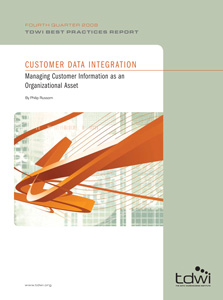
TDWI Best Practices Report | Customer Data Integration: Managing Customer Information as an Organizational Asset
October 1, 2008
Who are your customers? Which products and services are they buying across your enterprise? How much business have they transacted with your enterprise so far this year? Where do they conduct business besides your firm?
For many reasons, it’s difficult to know who your customers are, much less what they’re doing. For example, companies in industries like financial services, insurance, and retail have grown through the organic development of new products and the acquisition of products through mergers. The result is that many firms now have dozens of products and services, which the customer purchases and uses through many touch points, such as call centers, retail outlets, business reply cards, and Web sites. This isn’t just a large-corporation phenomenon; even relatively small businesses have multiple products and touch points.
For the sake of effective customer service, sales, account management, billing, shipping—you name it!—companies need to accurately recognize the customer across multiple lines of business and touch points, plus integrate the customer’s information across those for a more complete picture. To achieve these goals, many companies have turned to customer data integration (CDI).
Content Provided by
TDWI, IBM, Acxiom, DataFlux, HP, Informatica, Precisely, Teradata Aster, Trillium